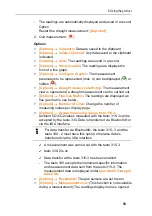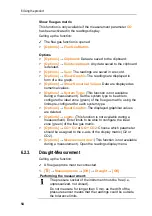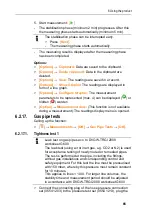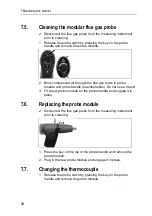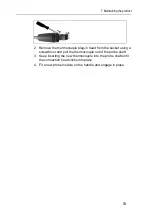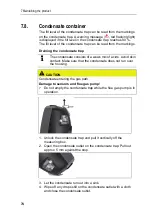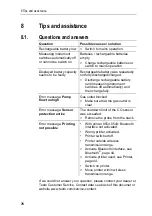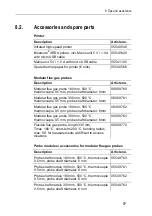
6 Using the product
66
pressure adapter onto the flue gas socket and lock in place by
slightly turning it clockwise (bayonet lock).
Performing the measurement:
✓
The pressure socket of the instrument must be free (i.e.
unpressurized, not closed).
1.
Tightness Test 1
→
[OK]
.
- Pressure
zeroing.
2.
Select parameter:
[
▲
]
,
[
▼
]
→
[Edit]
.
3.
Set parameters or enter values:
[
▲
]
,
[
▼
]
and partly
[
◄
]
,
[
►
]
→
[OK]
.
4.
Pressurise the system.
Once the pressure has built up, a stability time specified by
DVGW-TRGI 2008 should be observed to ensure that any
possible pressure fluctuations are not recorded in the
measurement. The relevant standard provides more
detailed information.
5.
Start measurement:
[
]
.
- The stability time will run. After this the measuring phase starts
automatically.
> End stability time and measurement early:
[Next]
.
- The readings are displayed when measurement has been
completed.
6.2.17.2.
Tightness test 2
• Follow DVGW-TRGI 2008, worksheet G624.
•
Pressure Absolute
(parameter of location) must strictly
be entered to obtain correct readings. If this is unknown
it is recommended to use the value 966hPa
(corresponds with 1013 hPa barometric, altitude 400 m)
To enter the values:
>
[ ]
→
Measurements
→
[OK]
→
Gas Pipe Tests
→
[OK]
→
[Tightness Test 2]
→
[Fold./Meas.]
→
[Options]
→
Edit Location
.
> Plug the connecting plug of the hose connection set
(0554 1203) into the flue gas socket and lock in place by turning
it slightly clockwise (bayonet lock).
Summary of Contents for 330
Page 1: ...testo 330 Flue gas analyzer Instruction manual ...
Page 2: ...2 ...
Page 82: ......
Page 83: ......
Page 84: ...0970 3310 en 10 en_DE ...


